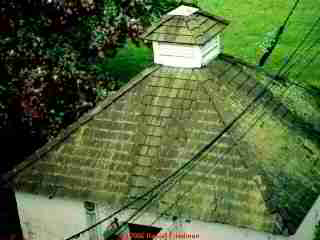 Asphalt Shingle Properties
Asphalt Shingle Properties
- POST a QUESTION or COMMENT about the properties of asphalt roofing materials
Properties of asphalt shingles:
This article discusses the key properties of asphalt roof shingles, compares organic and fiberglass matt shingles, lists and compares types of asphalt shingles: 3-tab, laminated, etc., and discusses shingle warranties, stains, wind resistance, and fire resistance.
We describe the following: Asphalt roof shingle quality comparisons. Organic vs Fiberglass Asphalt Roof Shingles. Manufacturing standards for asphalt shingles. Where to buy asphalt roof shingle products. Best practices for roofing material installation, flashing, ventilation, nailing, underlayment.
This article series discusses best practices in the selection and installation of residential roofing.
InspectAPedia tolerates no conflicts of interest. We have no relationship with advertisers, products, or services discussed at this website.
Properties & Types of Asphalt Roof Shingles
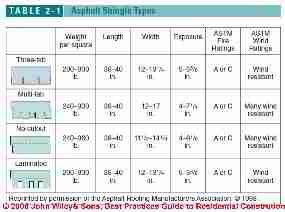 Adapted/paraphrased with permission from Best Practices Guide to Residential Construction (Steve Bliss, J Wiley & Sons) , chapter on BEST ROOFING PRACTICES:
Adapted/paraphrased with permission from Best Practices Guide to Residential Construction (Steve Bliss, J Wiley & Sons) , chapter on BEST ROOFING PRACTICES:
Asphalt shingles, which cover 80 to 90% of residential roofs, have undergone much change in the last 20 to 30 years. Until the late 1970s, all asphalt shingles were manufactured from a heavy organic felt mat that had established a reputation for both strength and flexibility and generally outlasted their 15- to 20-year life expectancy.
[Click to enlarge any image]
Since their introduction in the late 1970s, fiberglass shingles have come to dominate the market, accounting for over 90% of shingles sold today.
However, premature failure of some fiberglass shingles in the 1980s and 1990s tarnished the product’s reputation and spawned a number of lawsuits and resulted in a toughening of standards and a general improvement in fiberglass shingle quality.
Details about these fiberglass shingle problems are at CRACKS & THERMAL SPLITTING in FIBERGLASS SHINGLES.
Shingle styles have changed as well. The common three-tab shingles of the 1950s and 1960s are now joined by no-cutout shingles, multitab shingles, and laminated “architectural” shingles.
Table 2-1 (above left lists the types of asphalt roof shingles and the properties of each, including dimensions, weight, exposure, and wind ratings.
Laminated asphalt roof shingles provide deep shadow lines and a heavily textured appearance, some simulating wood or slate. These now account for over half the shingles sold.
Asphalt Roof Shingle Quality
Shingle quality is often difficult to determine visually since it is based largely on hidden factors such as the strength of the reinforcing mat (organic felt or fiberglass), the strength and flexibility of the asphalt, and the amount and type of fillers used. In most cases, however, the guidelines outlined below can help to select shingles that perform as promised.
Organic Felt vs. Fiberglass Asphalt Shingles
Organic shingles are built around a thick inner mat made from wood fibers or recycled paper saturated with soft asphalt. Fiberglass shingles, on the other hand, use a lightweight nonwoven fiberglass held together with phenolic resin.
Both shingles are then coated on top with a layer of harder asphalt and fillers and topped with colored stone to create a decorative surface and protect against ultraviolet light.
A thin layer of asphalt on the bottom is coated with a nonsticking dusting that keeps the shingles from sticking in the bundle. Each type has its pros and cons. Table 2-2 below compares the pros and cons of organic asphalt shingles (Standard ASTM D255) and fiberglass based asphalt shingles (Standard ASTM D3462).

Organic Asphalt Roof Shingles: Characteristics
In general, organic shingles have better tear resistance and resistance to nail pull-through than fiberglass shingles, making them less likely to blow away during a cold weather installation when they have not yet had a chance to seal.
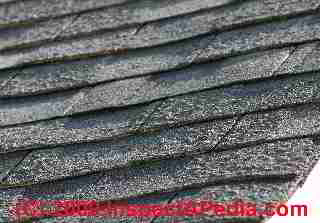 Also, some roofers find that organic shingles
are more pliable and easier to work with in cold
weather. On the downside, the organic mat is neither fireproof
nor waterproof. Organic shingles therefore typically
carry only a Class C fire rating.
Also, some roofers find that organic shingles
are more pliable and easier to work with in cold
weather. On the downside, the organic mat is neither fireproof
nor waterproof. Organic shingles therefore typically
carry only a Class C fire rating.
Although uncommon, manufacturing defects that allow water penetration into the mat can lead to premature curling and cupping of organic shingles.
Blistering (photo above left, for details see BLISTERS on ASPHALT SHINGLES) and curling (see CURLING ASPHALT SHINGLES) in warm climates has also been occasionally reported. Organic shingles cost more than comparable fiberglass shingles, but remain popular in colder regions and throughout Canada.
With organic shingles, shingle weight tends to be a good predictor of performance and longevity since the added weight usually indicates a thicker mat saturated with more soft asphalt.
Fiberglass Based Asphalt Roof Shingles: Characteristics
Fiberglass shingles, built on a thin nonwoven fiberglass core, were first introduced in the late 1970s and now account for over 90% of the shingles sold. Because they use less asphalt, they are lighter and generally less expensive than organic shingles. Because fiberglass mats are more fire-resistant and moisture-resistant than felt, most fiberglass shingles carry a Class A (severe exposure) fire rating and are less prone to cupping and curling from moisture damage.
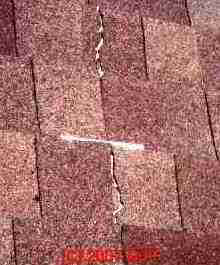 On the downside, fiberglass shingles
are generally not as tear-resistant as organic shingles,
making them more prone to blow-offs in cold weather
when the shingles have not properly sealed.
On the downside, fiberglass shingles
are generally not as tear-resistant as organic shingles,
making them more prone to blow-offs in cold weather
when the shingles have not properly sealed.
After they have sealed, they can still tear from movement in the sheathing, since fiberglass shingles have little give, unlike organic shingles. In this situation, if the bond strength of the adhesive strip exceeds the tear strength on a lightweight shingle, the shingles can crack.
Premature failure of some fiberglass shingles due to splitting or cracking led to a number of class-action lawsuits in the 1980s and 1990s. (Photo at left).
The problems were primarily with lower-end shingles with lightweight mats, types that have been largely eliminated from the market. But it still pays to buy ASTM-rated products from a reputable company that provides a good warranty. Details about these fiberglass shingle problems are at CRACKS & THERMAL SPLITTING in FIBERGLASS SHINGLES.
see Choosing an Asphalt Shingle: Organic vs. Fiberglass, Ted Cushman, The Journal of Light Construction, May 1993 for more about the debate around the advantages and disadvantages of organic mat asphalt shingles vs. fiberglass mat-based asphalt roof shingles.
Architectural Shingles - Laminated Asphalt Roof Shingles: Characteristics
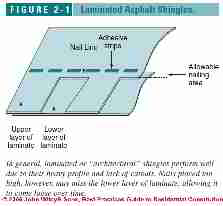
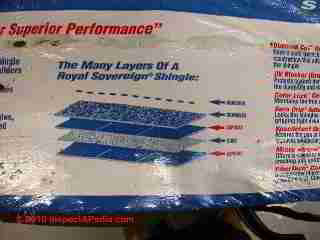
Also called “architectural” or “dimensional” shingles, these have two layers laminated together at the lower half of the shingle, giving the roof a thicker textured appearance with deeper shadow lines. Our photo (above-right) is a GAF illustration of their Royal Sovereign® laminated asphalt roof shingle.
Depending on the shape and size of the cutouts, half or more of the exposed shingle area is triple thickness and the rest double.
With the added thickness and without the tabs, which typically wear out first in three-tab shingles, most laminated shingles carry longer warranties as well as higher wind ratings, some as high as 120 mph.
While not immune to the problems of other shingles, such as premature cracking, it is reasonable to expect good performance from a reputable brand.
One problem unique to laminated shingles is the loosening of the bottom-most piece of the shingle caused, in part, by nailing above the line where the double thickness ends (Figure 2-1 above left).
On many laminated shingles, nails must be precisely placed so they are high enough to stay hidden while still penetrating both layers.
Wind Resistance of Asphalt Roof Shingles
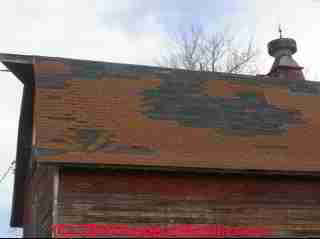 see WIND DAMAGE to ROOFS for details about this topic.
see WIND DAMAGE to ROOFS for details about this topic.
Most shingles carry a windresistance rating of 60 miles per hour as tested under ASTM 3161 or UL 997, while specialty shingles may be rated to as much as 130 miles per hour.
While laboratory tests may not predict actual performance in a storm, a higher rated shingle will likely perform better than a lower rated one.
Shingles rated at over 100 mph are often special order items and typically require six rather than the usual four nails per shingle.
Adding two extra nails and extra dabs of plastic roofing cement to a regular shingle can also increase its performance in high-wind conditions.
See FASTENING (NAILING) REQUIREMENTS FOR ASPHALT SHINGLE ROOFS
and MANUAL SEALING REQUIREMENTS FOR ASPHALT SHINGLE ROOFS.
A wind-resistance rating is not the same as a warranty.
Shingles that carry a wind-resistance warranty generally require that the shingle tabs have been adequately sealed to the adhesive strip and most limit wind coverage to five or ten years from installation. In cold, cloudy weather or on a steep north-facing slope, manual sealing with roofing cement may be necessary.
Algae Resistance of Asphalt Roof Shingles
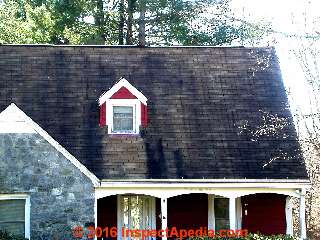 Black streaks on shingles caused by
algae or fungal growth used to be limited to warm, humid climates, but now this can be seen on houses as far north as Canada.
Black streaks on shingles caused by
algae or fungal growth used to be limited to warm, humid climates, but now this can be seen on houses as far north as Canada.
Some experts attribute the spread to the increased use of crushed limestone as a filler material in asphalt shingles.
Limestone is economical and makes a durable shingle, but the calcium carbonate in the limestone supports algae growth. In algae-resistant (AR) shingles, zinc or copper granules are mixed in with the colored stone topping.
When the shingles get wet, the zinc or copper is released, inhibiting algae growth.
Warranties for algae resistance are usually for less than 10 years since the protection ends when the mineral washes away. Some shingles have longer lasting protection than others due to a higher percentage of AR granules.
Details about algae stains and other stains found on roofs are at the series beginning at STAIN DIAGNOSIS on ROOFS
Also see ALGAE STAINS on ROOFS and STAINS on ROOF SHINGLES
Also see ALGAE, FUNGUS, LICHENS, MOSS on ROOFS
Definitions of Fire Ratings for Asphalt Shingle & Other Roofing Materials
Details about roof fire ratings and details about the applicable standards are at FIRE RATINGS for ROOF SURFACES. Excerpts are below.
Fire ratings for roof coverings describe how well the roof covering resists fires including the ability of the roof to resist catching fire from a lightning strike, if a spark or ember lands on it (say from a nearby chimney or from a forest fire), as well as the resistance to fire spread if the material is ignited.
Keep in mind that the purposes of roof covering fire ratings (to describe the fire resistance of a roofing material), and the intent of roof fire resistance in general are to allow building occupants more time to escape in event of a fire, not to guarantee that the building nor its occupants will be unharmed in the event of a fire.
A table of roof fire ratings and details about the applicable standards is at FIRE RATINGS for ROOF SURFACES.
- Class A roof covering fire rating: Highest fire resistance: the roof can withstand severe exposure to fire. See ASTM E-108 at FIRE RATINGS for ROOF SURFACES.
- Class B roof covering fire rating: Moderate fire resistance
- Class C roof covering fire rating: Light fire resistance
All roofing materials that carry any fire rating (A, B, or C) must:
- Apply to fires originating from outside the building.
- During or after a fire the roof materials will not:
- Blow off or fall off of the roof deck as flaming or glowing brands (burning embers that might further spread fire)
- Break, slide, crack, or warp to expose the underlying roof deck
- Allow the roof deck to fall away as glowing particles
- Allow sustained flaming of the underside of the roof deck
The U.S. Federal Housing Administration (FHA) and other lenders require that building roofing materials conform to these standards. Various U.S. national or model building codes & state & Canadian Provincial building codes or fire codes require that roofs must carry at least a Class C fire rating or better.
Watch out: if a roofing shingle or other roof covering material is not installed exactly according to the manufacturer's recommendations its fire rating may be compromised and reduced, as may the roof warranty too. Also, a roof that has resisted a fire successfully, and thus helped protect the building from a fire, is likely to need to be replaced after a fire or after exposure to high heat from a nearby fire.
Also watch for discount-grade roof shingles that may carry no fire rating whatsoever.
Also see these roofing material articles where we describe fire ratings:
- ASBESTOS & FIBER CEMENT ROOFING
- FIRE RETARDANT PLYWOOD
- WOOD ROOF COATINGS & FIRE RATINGS
- STANDARDS for ROOFING - our complete list of roofing standards
- above section added DF. Continuing from from Best Practices Guide to Residential Construction (Steve Bliss, J Wiley & Sons) :
Three Key Manufacturing Standards for Asphalt Roof Shingles: ASTM D-3462, ASTM D-225, ASTM D-3018
In the past, most companies did their own testing, but under pressure from contractors’ associations and others, most now use independent certifiers such as UL.
Note: See our complete list of roofing standards found at STANDARDS for ROOFING - there are a lot of them.
ASTM D3462 - Fiberglass shingles
ASTM D3462 - Fiberglass shingles are covered by ASTM D3462, which includes a tear test as well as a new nail-pull-through test added after fiberglass shingle failures started occurring in the late 1980s.
ABSTRACT: This specification deals with the standards for asphalt roofing in shingle form, composed of glass felt or felts impregnated and coated on both sides with asphalt, and surface on the weather side with minerals.
Physical requirements of the shingles such as behavior on melting, tear strength, wind resistance, fire resistance, softening point, and pliability shall be measured immediately after packaging or at a reasonable time. Physical and performance requirements after application and during in-service use are however beyond the scope of this specification.
ASTM D3462, "Asphalt Shingles Made From Glass Felt and Surfaced with Mineral Granules." American Society for Testing and Materials, ASTM International, West Conshohocken, PA, 2003.
A new pliability test was also added in recent years.
With fiberglass shingles, look for the UL label next to the ASTM D3462 certification.
This is not the same as a UL listing for a fire rating, which is printed on most fiberglass shingle packages. More and more jurisdictions are requiring compliance with ASTM standards, but discount shingles are still available with no certification.
As with many consensus standards, the ASTM D3462 requirement for tear strength of fiberglass shingles is considered by many experts to be a bare minimum rather than a guarantee of high quality. Also, once installed the shingles’ strength will likely diminish. So finding products that exceed the minimum is recommended for demanding applications.
ASTM D225 - 07 Organic Felt Asphalt Shingles
Organic asphalt shingles are covered under their own standard, ASTM D255
ASTM D225 - 07 Standard Specification for Asphalt Shingles (Organic Felt) Surfaced With Mineral Granules
ABSTRACT: This specification covers asphalt roofing in shingle form, composed of single or multiple thicknesses of organic felt saturated and coated on both sides with asphalt and surfaced on the weather side with mineral granules.
Materials shall meet specified dimensional and physical property requirements such as mass, behavior on heating (loss of volatile matter, and sliding of granular surfacing), wind resistance, fire resistance, weight of displaced granules, pliability, and saturant/coating compatibility.
ASTM Standard D225 - 07 "Standard Specification for Asphalt Shingles (Organic Felt) Surfaced With Mineral Granules", American Society for Testing and Materials, ASTM International, West Conshohocken, PA, 2003.
Related ASTM Roofing Standards:
D1079 - Terminology Relating to Roofing and Waterproofing
D1370 - Test Method for Contact Compatibility Between Asphaltic Materials (Oliensis Test)
D3161 - Test Method for Wind-Resistance of Asphalt Shingles (Fan-Induced Method)
D4977 - Test Method for Granule Adhesion to Mineral Surfaced Roofing by Abrasion
[ASTM D255-92 referred to in the original text, Standard Method for Steam Distillation of Bituminous Protective Coatings was superceded and was withdrawn in 2000. See ASTM D225 discussed above - Ed].
ASTM D 3018 - Class A Asphalt Shingles Surfaced with Mineral Granules
ASTM D3018 / D3018M - 10a Standard Specification for Class A Asphalt Shingles Surfaced with Mineral Granules
This specification covers mineral granule-surfaced asphalt roofing shingles. Covered here are the self-sealing (Type I) and non-self-sealing (Type II) types of shingles. The shingles shall consist of organic felt or glass mat(s) saturated or impregnated, and coated on both sides with a hot asphaltic material and completely surfaced on the weather side with mineral granules embedded in the coating.
The reverse side of the shingles shall be covered with a suitable material to prevent the shingles from sticking together in the package, causing possible damage upon being unpacked at ambient temperatures. Type I shingles shall have a factory-applied adhesive that will seal the shingles together after application.
Both types shall meet the conditions for Class A fire exposure, and loss and behaviour on heating tests. Type I shingles shall pass an additional wind resistance test.
ASTM D3018 / D3018M - 10a "Standard Specification for Class A Asphalt Shingles Surfaced with Mineral Granules", American Society for Testing and Materials, ASTM International, West Conshohocken, PA, 2003.
Warranties for Asphalt Roof Shingles
Shingle warranties run from 20 to over 50 years. Although products with longer warranties are usually of higher quality, in some cases, the longer warranties are more of a marketing strategy than an accurate predictor of shingle life. While the specific terms of the warranty are important, more important is the manufacturer’s reputation for warranty service in the local area.
All manufacturers retain the right to void the warranty if installation instructions are not closely followed, and they can often find a way to avoid honoring a claim if so inclined. Key issues to consider in a warranty are as follows:
- Is the warranty prorated from the date of installation, or is there an introductory term of 5 to 10 years when the full value can be recovered?
- How long are warranties valid against wind damage, algae growth, or other types of damage?
- Does the warranty cover a portion of the labor costs of tear-off, disposal, and installation, or does it cover materials only?
- Is the warranty transferable? Perhaps most importantly, does the manufacturer have a strong reputation for warranty service in the local area?
Details about roof shingle warranties are at WARRANTIES for ROOF SHINGLES
- - Adapted with permission from Best Practices Guide to Residential Construction (Steve Bliss, J Wiley & Sons) .
Resources: Roofing Materials & Equipment Suppliers
Asphalt Shingles
- Atlas Roofing Corp. www.atlasroofing.com Fiberglass and organic felt shingles
- Certainteed Roofing www.certainteed.com Fiberglass shingles
- Elk Premium Building Products www.elkcorp.com Fiberglass shingles
- GAF Materials Corp. www.gaf.com Fiberglass shingles
- Georgia-Pacific Corp. www.gp.com/build Fiberglass and organic felt shingles
- IKO www.iko.com Fiberglass and organic felt shingles
- Owens Corning www.owenscorning.com Fiberglass shingles
- Tamko Roofing Products www.tamko.com Fiberglass and organic felt shingles
Ridge Vents
- Air Vent/A Gibraltar Company www.airvent.com A complete line of roof ventilation products, including shingle-over and exposed-ridge vents with exterior wind baffles and internal weather filters. Also soffit and drip edge vents and passive and powered attic turbine-type vents.
- Benjamin Obdyke www.benjaminobdyke.com Shingle-over ridge vents. Low-profile Roll Vent uses nylonmatrix. Extractor vent is molded polypropylene with internal and external baffles.
- Cor-A-Vent www.cor-a-vent.com Shingle-over low-profile ridge vents, including Cor-a-vent, Fold-a-vent, and X-5 ridge vent, designed for extreme weather. Corrugated core.
- GAF Materials Corp. www.gaf.com Cobra vent: roll-out shingle-over ridge vent with a polyester-matrix core 102 CHAPTER 2 | Roofing
- Mid-America Building Products www.midamericabuilding.com Ridge Master and Hip Master shingle-over molded plastic ridge vents with internal baffles and foam filter
- Owens Corning www.owenscorning.com VentSure corrugated polypropylene ridge vents; also passive roof vents and soffit vents
- Trimline Building Products www.trimline-products.com Shingle-over low-profile ridge vents, Flow-Thru battens for tile roofs
- Elk Premium Building Products www.elkcorp.com Highpoint polypropylene shingle-over ridge vents
- Tamko Roofing Products www.tamko.com Shingle-over ridge matrix–type Roll Vent and Rapid Ridge (nail gun version) and Coolridge, which is molded polypropylene with external and internal baffles
Venting Underlayments
- Benjamin Obdyke www.benjaminobdyke.com Cedar Breather, a 3/8 -in.-thick matrix-type underlayment designed to provide ventilation and drainage space under wood roofing
More Information about Roofing Materials, Methods, Standards
- Asphalt Roofing Manufacturers Association (ARMA) www.asphaltroofing.org
#######
- - Adapted with permission from Best Practices Guide to Residential Construction (Steve Bliss, J Wiley & Sons) .
...
Continue reading at ASPHALT SHINGLE TEMPERATURES or select a topic from the closely-related articles below, or see the complete ARTICLE INDEX.
Or see see ASPHALT SHINGLE FAILURE TYPES
ASPHALT ROOF SHINGLES - home
ASPHALT SHINGLE INSTALLATION - best practices
WARRANTIES for ROOF SHINGLES and also WORKMANSHIP & WIND DAMAGE
Suggested citation for this web page
ASPHALT SHINGLE PROPERTIES at InspectApedia.com - online encyclopedia of building & environmental inspection, testing, diagnosis, repair, & problem prevention advice.
Or see this
INDEX to RELATED ARTICLES: ARTICLE INDEX to BUILDING ROOFING
Or use the SEARCH BOX found below to Ask a Question or Search InspectApedia
Ask a Question or Search InspectApedia
Try the search box just below, or if you prefer, post a question or comment in the Comments box below and we will respond promptly.
Search the InspectApedia website
Note: appearance of your Comment below may be delayed: if your comment contains an image, photograph, web link, or text that looks to the software as if it might be a web link, your posting will appear after it has been approved by a moderator. Apologies for the delay.
Only one image can be added per comment but you can post as many comments, and therefore images, as you like.
You will not receive a notification when a response to your question has been posted.
Please bookmark this page to make it easy for you to check back for our response.
Our Comment Box is provided by Countable Web Productions countable.ca
Citations & References
In addition to any citations in the article above, a full list is available on request.
- ARMA - Asphalt Roofing Manufacturer's Association - Asphalt Roofing Manufacturer's Association - https://www.asphaltroofing.org/
750 National Press Building, 529 14th Street, NW, Washington, DC 20045, Tel: 202 / 207-0917 - ASTM International, 100 Barr Harbor Drive, PO Box C700, West Conshohocken, PA, 19428-2959 USA The ASTM standards listed below can be purchased in fulltext directly from http://www.astm.org/
- NRCA - National Roofing Contractors Association - Website: www.nrca.net 10255 W. Higgins Road, Suite 600, Rosemont, IL 60018-5607, Tel: (847) 299-9070 Fax: (847) 299-1183
- UL - Underwriters Laboratories - https://www.ul.com/
2600 N.W. Lake Rd.
Camas, WA 98607-8542
Tel: 1.877.854.3577 / Fax: 1.360.817.6278 E-mail: cec.us@us.ul.com - "Choosing an Asphalt Shingle: Organic vs. Fiberglass", Ted Cushman, The Journal of Light Construction, May 1993, pp. 11-14. Used with Permission from the Journal of Light Construction.
- The Journal of Light Construction has generously given reprint permission to InspectAPedia.com for adaptations, quotations, or reproductions used at this website. All rights and contents of the JLC material are ©Journal of Light Construction and may not be reproduced in any form.
- "Which Asphalt Shingle is Better?" [Organic shingles vs Fiberglass roof shingles], Tom Bollnow, Professional Roofing, Sept. 1999 p. 70, O'Hare International Center, 10255 W. Higgins Road, Suite 600, Rosemont, IL 60018-5607, Telephone: (847) 299-9070, E-mail: professionalroofing@professionalroofing.net. Professional Roofing Magazine is a publication of NRCA, the National Roofing Contractors Association. [Permission requested 9/26/10].
- Our recommended books about building & mechanical systems design, inspection, problem diagnosis, and repair, and about indoor environment and IAQ testing, diagnosis, and cleanup are at the InspectAPedia Bookstore. Also see our Book Reviews - InspectAPedia.
- Best Practices Guide to Residential Construction, by Steven Bliss. John Wiley & Sons, 2006. ISBN-10: 0471648361, ISBN-13: 978-0471648369, Hardcover: 320 pages, available from Amazon.com and also Wiley.com. See our book review of this publication.
- Decks and Porches, the JLC Guide to, Best Practices for Outdoor Spaces, Steve Bliss (Editor), The Journal of Light Construction, Williston VT, 2010 ISBN 10: 1-928580-42-4, ISBN 13: 978-1-928580-42-3, available from Amazon.com
- Problems in Roofing Design, B. Harrison McCampbell, Butterworth Heineman, 1991 ISBN 0-7506-9162-X (available used)
- Roofing The Right Way, Steven Bolt, McGraw-Hill Professional; 3rd Ed (1996), ISBN-10: 0070066507, ISBN-13: 978-0070066502
- In addition to citations & references found in this article, see the research citations given at the end of the related articles found at our suggested
CONTINUE READING or RECOMMENDED ARTICLES.
- Carson, Dunlop & Associates Ltd., 120 Carlton Street Suite 407, Toronto ON M5A 4K2. Tel: (416) 964-9415 1-800-268-7070 Email: info@carsondunlop.com. Alan Carson is a past president of ASHI, the American Society of Home Inspectors.
Thanks to Alan Carson and Bob Dunlop, for permission for InspectAPedia to use text excerpts from The HOME REFERENCE BOOK - the Encyclopedia of Homes and to use illustrations from The ILLUSTRATED HOME .
Carson Dunlop Associates provides extensive home inspection education and report writing material. In gratitude we provide links to tsome Carson Dunlop Associates products and services.

